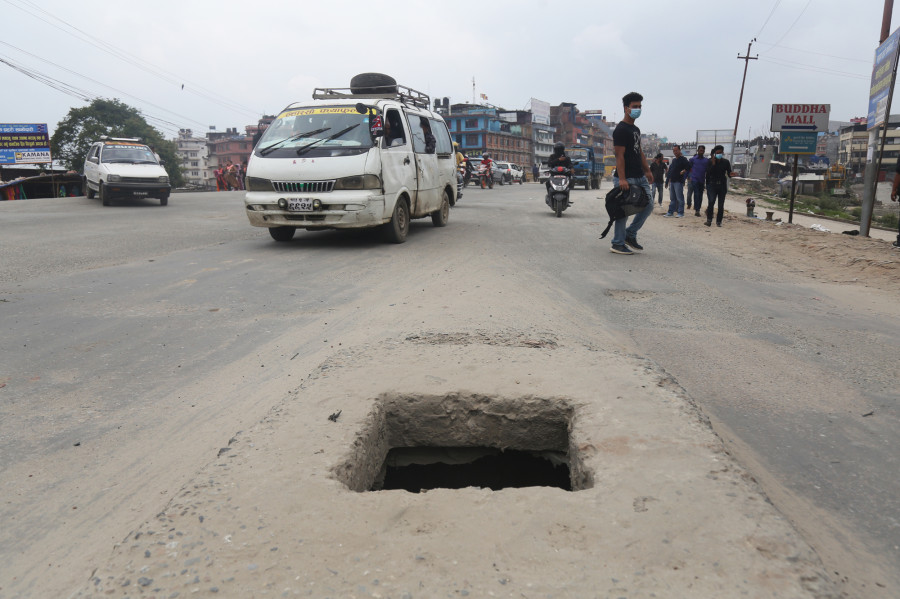Valley
As monsoon nears, open drains and uncovered manholes pose even bigger risks
Heavy rains tend to flood the Valley’s streets, obscuring open drains and manholes from motorcyclists, cyclists and pedestrians
Anup Ojha
About three weeks ago, Shubhechchha Bhatta was returning home from Jhamshikhel on her scooter. It was around 7:15pm and dark when she reached Chakupat. Driving in a light rain with no street lights around, Bhatta couldn’t see a manhole that had been left open for drainage works. She fell in, injuring her right shoulder and right leg.
“Luckily, there were some pedestrians around who helped me out of the seven-foot-deep manhole,” said Bhatta, a transport engineer and avid cyclist, who had to be admitted to the hospital for three days.
“If the manhole had water in it and if there was no one around to help me, I could have easily died,” she said.
In Kathmandu, unrepaired roads, open drainage sewers and uncovered manholes are not anomalies—they’re the rule. And with the monsoon incoming, things are bound to get worse, as drains overflow and roads flood, hiding these potential deathtraps under layers of water.
“We get more complaints when it rains,” said Deputy Superintendent of Police Hobindra Bogati, spokesperson for the Metropolitan Police Range, Kathmandu. “The drainage system is very poor in the Kathmandu Valley so when it rains, cyclists, motorcyclists and pedestrians often fall into open drains or manholes as they cannot spot them because of waterlogged roads.”
In July 2017, Binita Phuyal, a 12-year-old, died after she fell into an open drain in Tarkeshwar Municipality. That same year, another teenage schoolgirl was swept into a drainage pipe during heavy rains. Miraculously, she survived after the water current pushed her out at the other end.
Such incidents cause concerns among many, but especially parents of young children and schools in the Valley.
“When it rains, these open pits become invisible with flooding water, which our students cannot see when they’re to and from school,” said Puskar Nath Phulara, coordinator of LRI School, in Kalanki.
With the monsoon scheduled to arrive soon, there are widespread concerns that such accidents could recur, particularly in densely populated areas like Kalanki, Sitapaila, Gongabu, and Chabahil, where roads are notoriously bad and have numerous manholes and open drains.
But it is not just unwary schoolchildren who are at risk. Cyclists and motorcyclists are equally prone to falling into open manholes and severely injuring themselves. In October last year, cyclist Shyam Shrestha died after falling into an open drain in Kirtipur.
“This issue has to be addressed immediately, or it could bring about another catastrophe,” said Ratna Shrestha, founder and president of Nepal Cycle Society. “There are so many manholes and open drains, which are ‘death traps’ for cyclists like us.”
When the Post contacted Bina Magar, minister for water supply and sanitation, to inquire about the problem, she said that her ministry had already directed all government agencies “to be cautious”.
“We have already directed Kathmandu Upatyaka Khanepani Limited, the Project Implementation Directorate under the Melamchi Drinking Project, and other concerned agencies to place prominent signs where pipelines are being laid or where drainage works are being carried out,” said Magar.
Tiresh Prasad Khatri, project director of Melamchi Sub-Project II of the Project Implementation Directorate, confirmed that his office had received the minister’s instructions.
“Starting June 15, we won’t be digging up the roads until the monsoon is over,” said Khatri.
Every year, Kathmandu floods during the monsoon. Videos are shared widely on social media of pedestrians wading through ankle-deep rivers of rainwater and sewage. And every year, locals criticise the city government for failing to provide adequate drainage. Last year, after widespread criticism, Mayor Bidya Sudar Shakya had vowed to clean and open up blocked drainage canals.
However, when the Post reached out to the city office, few specifics were forthcoming.
“We have already directed all the 32 wards representatives to close open drainage and manholes,” said Ishwor Man Dangol, spokesperson for the metropolitan city office. “We are also planning to put temporary railings along the sides of the roads where water collects during the rainy season.”
But Shrestha of Cycle Society does not believe that these measures are adequate.
“The government is not serious about the safety of pedestrians and cyclists. There are still so many open drains and manholes all across the city,” said Shrestha. “Last year, we lost one of our friends. I don’t know when the authorities are going to fix the problem so that we don’t lose another one.”




 16.12°C Kathmandu
16.12°C Kathmandu.jpg)










